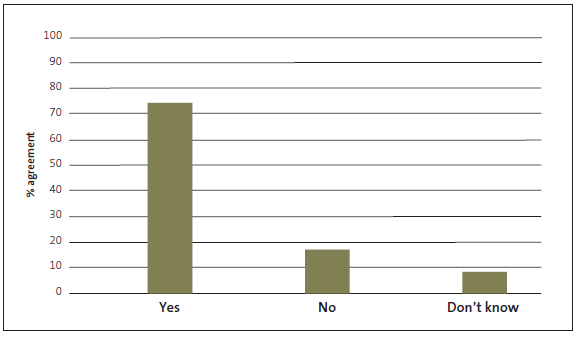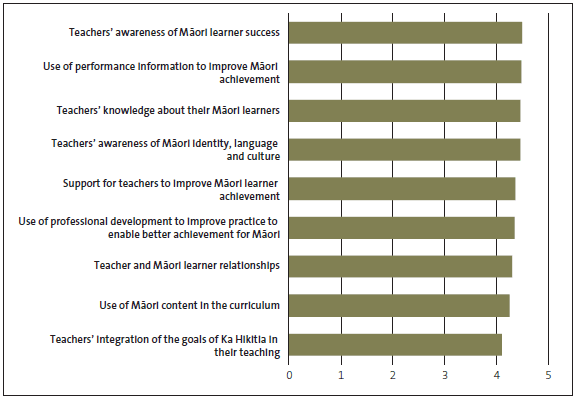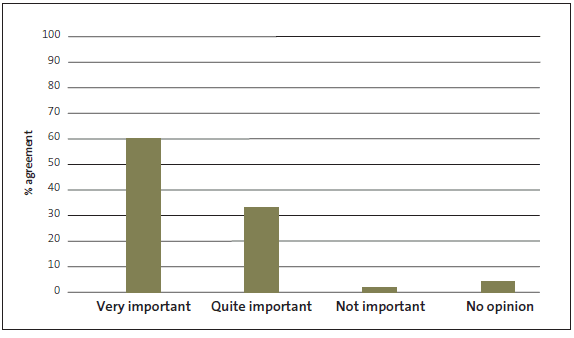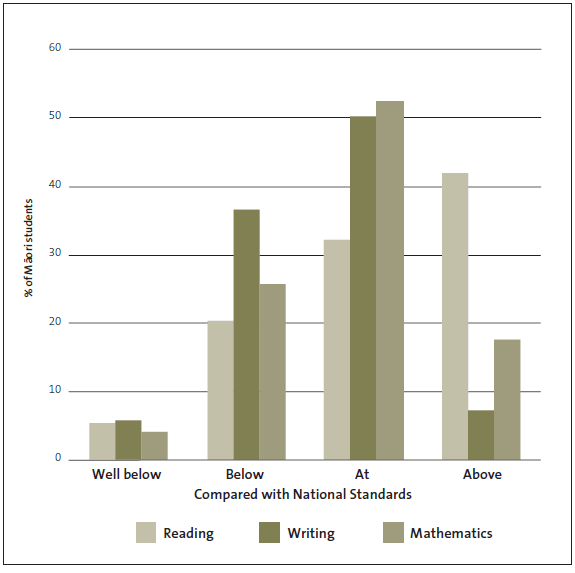Part 5: The effect of Ka Hikitia on teaching and what students achieve
5.1
In this Part, we discuss:
- the effect of Ka Hikitia on student outcomes and experiences;
- the effect that Ka Hikitia has had on teaching;
- useful examples of how Ka Hikitia has been effective in some of the schools we visited; and
- the effect of Ka Hikitia, assessed against the target measures of success.
Year 6 student
5.2
Ka Hikitia has contributed to an improved awareness of Māori students' educational success in the wider education sector. Many students we talked to affirmed their positive experience of schooling and their relationships with teachers. However, data measuring the effect of Ka Hikitia in terms of Māori students' achievement shows that Ka Hikitia is only now starting to be integrated into schools' planning and practice.
Helping students to recognise the importance of succeeding as Māori
Māori students recognise what good teachers do to support their educational success.
5.3
During this performance audit, we were impressed by students' ability to discern what good teaching for them was, what they needed, their optimism for the future, knowledge of their learning progress, and how their teachers and their families could and should support them. The students we talked to were proud to be Māori, and almost all believed that Māori cultural needs were valued in school as an important part of their learning context.
5.4
Students told us:
The teachers know us. We can talk to the teachers. (Year 10 student)
Success means keeping the culture alive. (Year 8 student)
I was in kohanga reo and then went to mainstream at primary school and lost my Māori language. (Year 13 student)
Ka Hikitia's positive effect on teaching
Ka Hikitia has contributed to increased commitment to improve Māori students' success in education and teaching practices that recognise Māori identity, language, and culture.
5.5
The introduction of Ka Hikitia is linked to an improvement in how schools approach lifting Māori students' outcomes. About three-quarters of respondents to our survey said that Ka Hikitia had led to a change in their schools (see Figure 5).
Figure 5
Survey respondents' perceptions of whether Ka Hikitia has led to a change in their school

Note: Scores are an average of the respondents' answers. 1 is a marked change for the worse and 5 is a marked improvement.
Source: Survey results, question 8 (see Appendix).
5.6
ERO identified in 2010 and again in 2012 that Ka Hikitia has contributed to leaders making changes in schools where Māori students' achievement then improved. ERO noted that this improvement was "statistically significant" but also that it was not possible to directly attribute it to Ka Hikitia.36 This is in line with our findings.
5.7
Changes in teachers' awareness of the success of Māori students and knowledge about Māori students were reported through our survey. The main shifts that respondents perceived were in teachers' awareness of Māori identity, language, and culture, the use of performance information to improve Māori students' achievement, and teachers' knowledge about their Māori students (see Figure 6).
Figure 6
Perceived changes in teaching and teaching practice

Note: Scores are an average of the respondents' answers. 1 is a marked change for the worse and 5 is a marked improvement. Source: Survey results, question 9 (see Appendix).
5.8
When we visited schools, we heard a strong commitment to improve results for Māori students. School leaders made frequent reference to the use of student performance information to improve planning, monitoring, and reporting.
5.9
The Ministry has a new process and a new procurement policy to manage professional learning and development.37 Professional learning and development is now based on needs, rather than driven by demand. For professional learning and development to be delivered in 2011, the Expression of Interest process made it clear that, among other things, providers would need to consider how their professional learning and development work would reflect Māori interests, showing credibility, responsiveness, and working in ways that support close relationships with iwi and whānau.
5.10
Educators are supportive of the overall intentions of Ka Hikitia, and many consider it very important (see Figure 7). Many schools are taking action to improve Māori students' achievement. Some of the actions were reflected in Ka Hikitia. The aims of Ka Hikitia are in line with school sector initiatives and helped to strengthen the mandate for schools to continue or further their own initiatives to improve Māori students' achievement.
Figure 7
Survey responses to question about the perceived importance of Ka Hikitia

Source: Survey results, question 12 (see Appendix).
Some successful teaching practices
Ka Hikitia works indirectly and directly, and when there are few Māori students in a school.
5.11
We read or heard reports, from the school leaders and teachers in the schools we visited, ERO reports about those and other schools, and through our survey, about Ka Hikitia working in a variety of ways. In our view, Ka Hikitia:
- is more useful when applied with high-quality professional learning and development;
- can work in indirect ways (for example, through raising general awareness or through school leaders who run programmes and activities to support Māori student outcomes without overtly relating these to Ka Hikitia);
- has helped to identify that Māori student achievement is important; and
- is relevant even where there are few Māori students.
5.12
The descriptions in paragraphs 5.13-5.35 show why we have formed these views.
When paired with professional learning and development, Ka Hikitia changes teachers' ideas about teaching practices.
5.13
The teachers at a South Auckland primary school had already been working with the community to improve Māori educational success. This helped the teachers to understand Ka Hikitia well and they felt it affirmed what they had already been doing. They felt that, although Ka Hikitia was not a high-profile document in the school, the school "lives and breathes" the goals of Ka Hikitia and had been doing so before Ka Hikitia. Because of this understanding, teachers found Ka Hikitia to be a user-friendly document and easy to read. Teachers were able to tell us about the goals of Ka Hikitia and the concept of ako.
5.14
The principal and staff praised the learning that was available through the Papakura Achievement Initiative (PAI) and related it to the strategic goals of Ka Hikitia. PAI is a Ministry-sponsored intervention to support Ka Hikitia through improving literacy, improving teaching and learning, building evaluative capability, strengthening pedagogy, embedding formative assessment practices, and improving the analysis of data.
5.15
ERO has reported that the participation of teachers from this South Auckland school in PAI "has increased professional growth, improved the quality of teaching, and developed the leadership skills of staff".
5.16
At the school, Ka Hikitia and PAI have increased understanding about what the evidence says matters for improving Māori students' educational success, beliefs in Māori potential, and efforts in the school to enact major goals to improve teaching and learning. The Ka Hikitia principle of Māori potential was evident in the teaching philosophy of every teacher we spoke with. Teachers reflected other aspects of Ka Hikitia, such as affirming the need to build on what students bring to school and who they are. Ka Hikitia gave recognition to the ideas Māori staff had about what is important for Māori students.
5.17
The South Auckland school has built on what it learned from PAI and Ka Hikitia. It has a strong commitment to providing a culturally responsive and congruent learning environment for Māori students. Teachers' professional learning goals have included working through Tātaiako with a third party, focusing on improving te reo Māori as a staff, sharing good practice with each other as teachers (including going into each other's classrooms), taking Ministry-led webinars on Ka Hikitia (which, for one staff member, catalysed a focus on improving relationships with Māori whānau). Māori staff felt that Ka Hikitia had improved the environment for things Māori and accurately reflected their aspirations for Māori achievement and valued outcomes for Māori students.
5.18
The results of the work the South Auckland school has done, especially the attention given to reading, are likely to have contributed to the results shown in Figure 8, which shows that more than 42% of Māori students at the school are achieving above the National Standard for reading. At present, the data is, at best, indicative. However, Figure 8 shows that, for this one school, although many Māori have done well, there is still a long way to go, with some Māori students below the standards and some well below.
Figure 8
How Māori students at one South Auckland primary school compare with the National Standards in reading, writing, and mathematics

Source: Ministry of Education, analysis of variance reporting for 2011.
Contributing indirectly
5.19
One primary school in a provincial city is doing well for Māori students, who make up one- third of the school enrolment. Eighty-one per cent of students are achieving at or above the National Standard for reading, and 79% are at or above the National Standards for reading, mathematics, and writing.
5.20
The school's leaders said that this was because of a philosophy of early intervention, help from the Ministry regional office, reading recovery support, and linking performance data and performance management. The board of trustees said that, among other factors, the strong focus on the individual, the school culture of openness and inclusiveness, the commitment to consistent quality, staff teamwork, and high expectations of teachers and students, were helping to produce successful Māori students.
5.21
In its most recent report about this provincial city school, ERO said:
Relationships are positive and affirming between students and with teachers. A strong culture of respect and support for others is evident.
5.22
The ERO report also noted positive and trusting relationships with accessible and respected teachers and adults.
5.23
The eight students we spoke with were, overall, a positive and confident group who interacted respectfully with each other. They were thoughtful and articulate. Most of the group were used to hearing and using te reo Māori around the home and showed a positive attitude to themselves as Māori. The students displayed positive attitudes to a wide range of academic subjects, including reading, mathematics, art, science, and physical education, and many had an active interest in sport. There was high awareness of the value of tikanga and te reo Māori. Kapahaka is important to them. They are proud to be Māori in a supportive school environment. Students can readily identify explicitly Māori aspects of classroom programmes.
5.24
In this provincial city school, we see the success of Māori students as an indirect result of Ka Hikitia. The principal told us of several motivational influences to catalyse and drive change and greater focus on Māori achievement at this school. These included a presentation about Te Kotahitanga from the directors of the programme (Mere Berryman and Russell Bishop) and ERO reviews that prompted reflection about improvement. The school engaged strongly with whānau and community, using many techniques and approaches to strengthen relationships with whānau, and is open to having whānau in classrooms. The principal models the expected "outreach" behaviour by taking part in after-school duty at the school gate and talking to whānau. Teachers are expected to telephone students' homes with positive comments and suggestions before raising any concerns. The way senior managers model commitment to Māori has nurtured teachers' attitudes and capability. These practical ways of gaining whānau trust and engagement with children's learning seem to have worked well for this school and for the results that Māori students attain.
5.25
The school staff we spoke with told us that the aims and aspiration of Ka Hikitia were correct but that the Ministry should be more forthright with the sector in focusing on Māori students' educational success, as they were with National Standards.
5.26
The contributions of academics, a demand from whānau to focus on improvement, and a Māori teacher were all part of the mix that helped teachers to help Māori students to be successful. The principal told us: "You have to take a long-term approach. We're working gently and carefully."
Making Māori students' success important
5.27
One high school in a small Northland town had made a thorough, comprehensive, and long-term effort to focus on and raise the success levels of Māori students through Te Kotahitanga. The principal told us: "Ka Hikitia provides the will but not the way." Although she did not think Ka Hikitia was practical, she said that Ka Hikitia had provided legitimacy to the school's focus on Māori students' success.
5.28
The students we spoke with were well aware of the Te Kotahitanga programme and that it started some years ago. The students showed us, with pride, the performance information that was being used to track their progress. We saw this detailed information posted on the wall of a classroom. The students recounted their experiences at other schools where the teachers did not believe in them the way they felt believed in at this school and where the teaching standards were, as they put it, "slack". The focus on performance seemed clear to them.
5.29
The students appreciated the high expectations teachers had of them and the effort to make subjects and activities interesting and appealing. One spoke of how the improvement in her grades, after transferring from another school, convinced her parents to send her sister to this new school.
5.30
The students echoed our own experience on entering this school when they told us that the school made them feel welcome. In the words of one student, "I like that an English school involves Māori things, even little things." Although they suggested that some improvements could be made in the facilities for teaching te reo, all the students said that the school was doing well for Māori students.
Relevance to schools with few Māori students
5.31
A primary school in a well-off part of Auckland has few (only 6%) Māori students. The Māori students who attend this school do as well as the non-Māori students. However, the school has looked at the education it offers and how it can be improved to result in greater success for Māori students.
5.32
The principal showed strong and committed leadership, despite Ka Hikitia being challenging at first for the board of trustees and the school. Even though there are relatively few Māori students, the school has committed to putting Ka Hikitia into effect. The principal had a sense of the importance of understanding Māori and New Zealand history. The school had been involved in the Auckland Council conservation programme, Enviroschools, and was committed to kaitiakitanga (care for the environment).38
5.33
The Ministry contracted a professional learning and development provider to introduce Ka Hikitia to the school. A challenge from teachers at the introductory meeting could have been handled better. However, the provider worked with the school's senior leaders so that they could gain the staff's acceptance of, and enthusiasm for, Ka Hikitia and the need to be responsive to Māori. The provider introduced the Ministry's MGF to the school, which has adopted some MGF principles into its practices.
5.34
To achieve significant changes in this Auckland school, it was important to move slowly to ensure that Ka Hikitia would be sustainable. The school received strong support from Māori whānau in this journey. However, teachers' views about the case for change vary.
5.35
The main guidance for teachers at this Auckland school comes through school leaders' modelling commitment to culturally responsive pedagogy, from Resource Teachers: Learning and Behaviour39, and through a professional learning and development programme and other support for teachers from the specialist teacher in te ao Māori. The principal participates in several formal and informal clusters for principals, but more sharing of professional practice would promote the value of the clusters.
Effect on the target measures of success
5.36
Despite gradual improvement, delaying and inadequately implementing Ka Hikitia has led to negligible progress since 2009.
5.37
In our view, the connections between the goals and targets in Ka Hikitia for the school sector are logical. Ka Hikitia contains 25 targets for measuring success. The targets reflect the main ideas of the goals: participation and achievement. There are an appropriate number of targets to measure performance. There are enough to be comprehensive, but not too many to overload understanding. They are also different enough, the goals are broad enough, and the targets specific enough that there is little danger of the targets becoming an end in themselves, displacing the goals.
5.38
For the 13 targets that are relevant to the school sector and that are reported on the Ministry's Education Counts website, we observe that overall results are improving slowly.40 The Ministry's evaluation of Ka Hikitia in 2012 concluded that there were gains compared with the 2000-09 period and that all the measures show an improvement trend. However, overall, the Ministry assesses Ka Hikitia as having been "minimally effective to developing effectiveness" in terms of the targets for student outcomes.
5.39
We acknowledge that the Ministry has improved how it measures early childhood participation, school leaver achievement data, and truancy as new systems have provided better data (such as the electronic enrolment management system and increased prevalence of electronic attendance registers in schools). The improved measurement has led to revision of progress and targets. The Ministry has effectively communicated the targets and disclosed relevant information about them although there are minor problems with understanding the information resulting from the target revisions.
5.40
The performance of Ka Hikitia as measured by the Ministry is mixed. This might be the effect of delaying and inadequately putting Ka Hikitia into effect or it could be that Ka Hikitia must be in place longer for the measures to show change. We discussed how Ka Hikitia was introduced in detail in paragraphs 3.7-3.24.
36: Education Review Office (2010), Promoting Success for Māori Students: Schools' Progress, Wellington, page 9. ERO included several questions about the use of Ka Hikitia (partly for the purposes of this audit) in reviews of schools in Term Four 2012.
37: The changes noted by the Ministry are to move from a partly contestable process for preferred providers to a fully contestable process, and from schools and kura making their own arrangements with providers to schools and kura working with regional Ministry staff to identify needs for professional learning and development.
38: To see more about Enviroschools, see www.enviroschools.org.nz.
39: Resource Teachers: Learning and Behaviour are experienced teachers trained to support the needs of students whose achievement in learning and behaviour is not being fully realised and to support their school and teacher.
40: See the Ministry's Education Counts website, www.educationcounts.govt.nz.
page top
